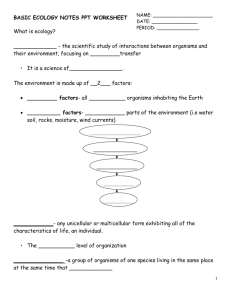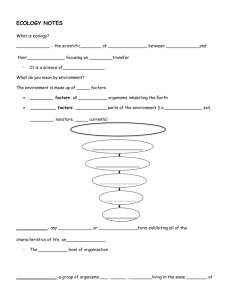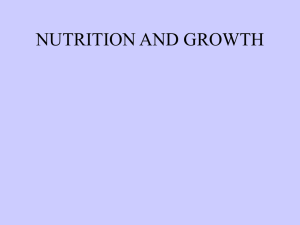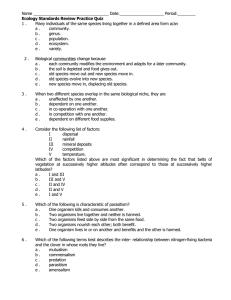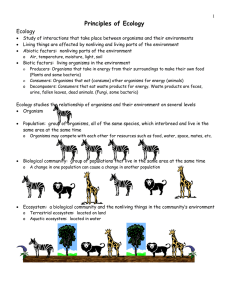BASIC ECOLOGY NOTES PPT WORKSHEET NAME: _____________________ DATE: ________________ PERIOD: _______________
advertisement
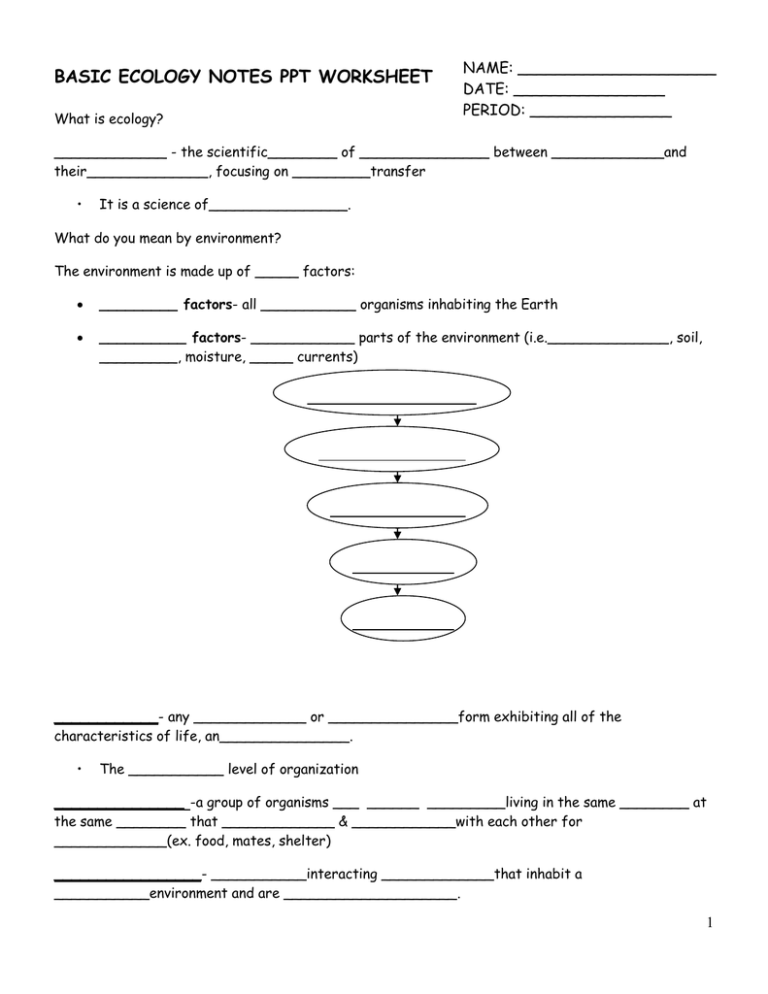
BASIC ECOLOGY NOTES PPT WORKSHEET What is ecology? NAME: _____________________ DATE: ________________ PERIOD: _______________ _____________ - the scientific________ of _______________ between _____________and their______________, focusing on _________transfer • It is a science of________________. What do you mean by environment? The environment is made up of _____ factors: _________ factors- all ___________ organisms inhabiting the Earth __________ factors- ____________ parts of the environment (i.e.______________, soil, _________, moisture, _____ currents) ____________- any _____________ or _______________form exhibiting all of the characteristics of life, an_______________. • The ___________ level of organization _______________ -a group of organisms ___ ______ _________living in the same ________ at the same ________ that _____________ & ____________with each other for _____________(ex. food, mates, shelter) _________________- ___________interacting _____________that inhabit a ___________environment and are ____________________. 1 _______________- populations in a ________________ & the __________ factors with which they interact (ex.___________, terrestrial) ________________- life supporting portions of _________composed of air, _______, fresh water, and salt water. • The _____________ level of organization Habitat vs. Niche _________- the ________ a species plays in a community (job) ____________- the _________ in which an organism __________ out its life (address) A __________is determined by the _____________ _____________of an organism, or a____________ __________. _____________ factor- any biotic or abiotic factor that _________ the ____________of organisms in a specific environment. Examples of limiting factors• Amount of _________ • Amount of _________ • _______________________ Feeding Relationships • There are ___ main types of feeding relationships 1. ____________- _____________ 2. ___________- _______ 3. ___________- _______ ___________- all _____________ (plants), they trap __________ from the ______ - __________ of the food chain _____________- all________________: they ________ _______ containing the sun’s energy • • • • _____________ Carnivores ________________ Decomposers 2 Herbivores – Eat __________ • ______________ consumers • ________ animals Carnivores • ______________ – • Eat ________ ________ prey animals for food. _______________ – Omnivores Decomposers Feed on ___________, dead animals Eat _______ plants and animals • _______________ the complex compounds of ______and decaying plants and animals into simpler _____________ that can be ______________ Symbiotic Relationships ______________- _____ species living ____________ ___ Types of symbiosis: 1. __________________ 2. _________________ 3. ________________ __________________- ____ species ___________ and the other is _________ harmed nor helped Ex. ____________ on a tree, ________ bears and cyanobacteria ____________: A________, such as a tropical orchid or a bromeliad, that _______on another plant upon which it __________for mechanical support but ____for______________. Also called aerophyte,___ _______. _______________- _____ species ___________(parasite) and the _________ is __________ (host) • Parasite-______ relationship Ex. lampreys, ___________, fleas, _______, tapeworms 3 _____________- ____________ to _______ species Ex. cleaning _________ and cleaner shrimp, _________ Symbiosis Review Type of relationship Species harmed Species benefits Species neutral 1. 2. 3. Trophic Levels • Each ______ in a food ________is known as a _________ level. • Trophic levels ___________ a feeding ______ in the _________ of _________ and matter in an ecosystem. ____________- the _________ of __________ matter comprising a group of organisms in a habitat. • As you move ___ a food chain, both available _________ & _________ ____________. • _________ is transferred upwards but is _____________ with each transfer. ________ chain- __________ model that shows how matter and __________ move through an ecosystem Draw a sample food chain that you might see in Virginia: include a producer, a primary consumer, a secondary consumer, and a tertiary consumer _____________ _____________ ______________ _____________ 4 Food ______- shows ____ possible feeding ______________ in a community at each _________ level • Represents a ____________ of interconnected food _________ Food chain- just ___ path of energy Food web- ____ possible energy paths Nutrient Cycles Cycling maintains _______________ (balance) in the environment. • ___ cycles to investigate: 1. ________ cycle 2. _________ cycle 3. _____________ cycle ________ cycle- evaporation, _______________, condensation, ________________ _________ cycle- _________________ and ______________ cycle carbon and ___________ through the environment. ___________ cycle___________________ nitrogen (N2) makes up nearly ___ %-___ % of air. Organisms ____ _____ use it in that form. _____________ and ___________ convert nitrogen into ___________ forms. Only in certain ____________ and industrial ______________ can _____ nitrogen. Nitrogen______________ - __________atmospheric nitrogen (N2) into ____________(NH4+) which can be _______ to make organic compounds like__________ ________. Nitrogen-fixing_____________: Some live in a ______________ relationship with plants of the ____________family (e.g., soybeans, clover,____________). • Some ____________-fixing bacteria live _______ in the_______. • Nitrogen-fixing ________________are essential to maintaining the fertility of semi__________ environments like ______ paddies. __________ in food chains- 5 While energy ____________ as it moves up the food chain, __________ ___________ in potency. • This is called _________________ ________________ Ex: ______ & Bald ___________ 6
